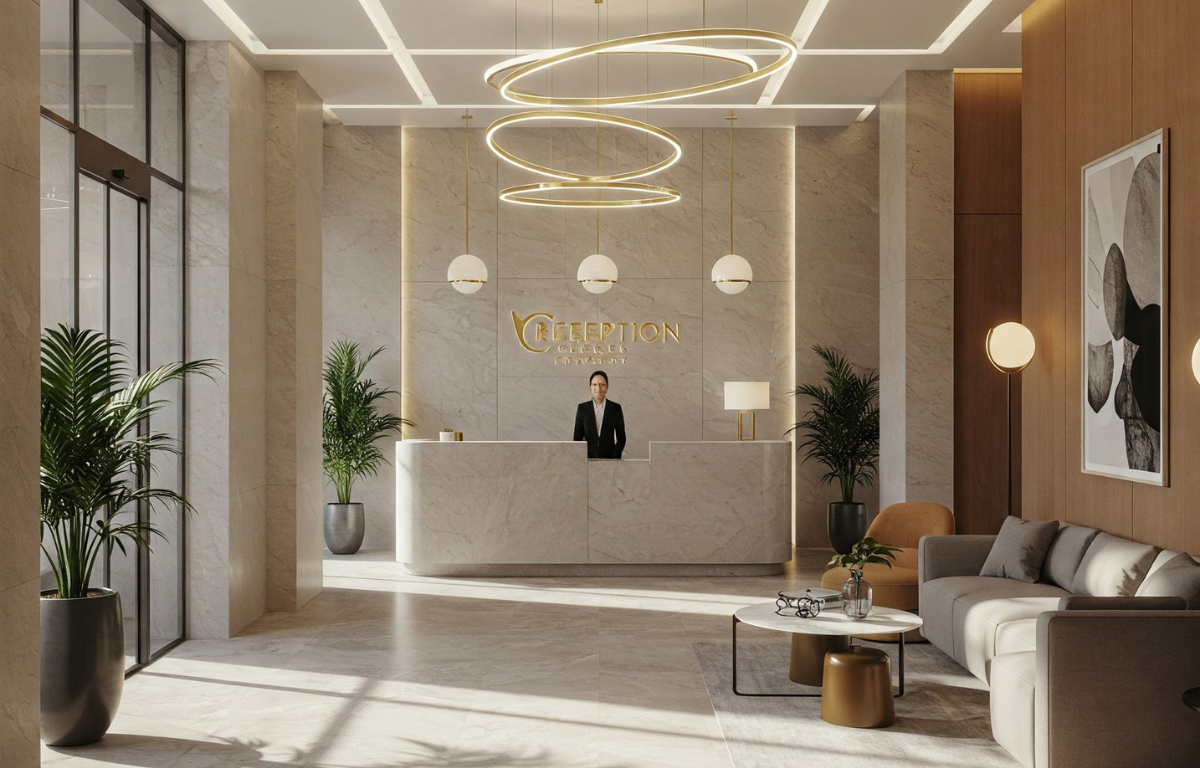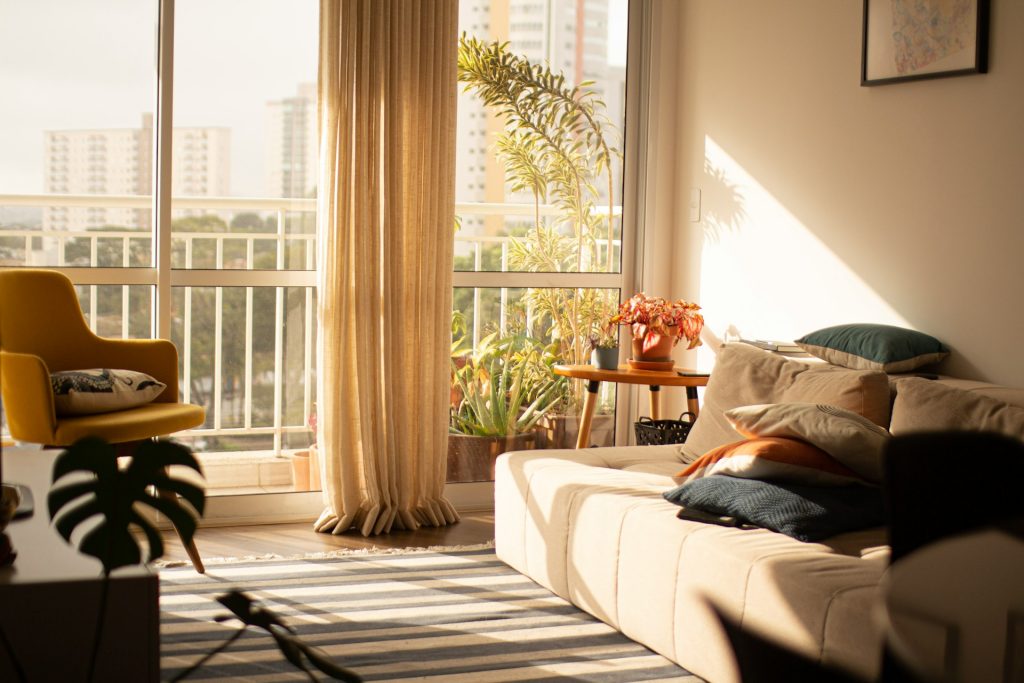The reception area is the face of your business, the very first point of contact for visiting clients and guests. It’s a crucial space that sets the tone for their entire experience and can significantly impact their perception of your company’s professionalism, values, and attention to detail. Designing a welcoming reception area is an investment in building strong client relationships and fostering a positive brand image. This guide will walk you through the essential elements of creating a reception area that is both inviting and functional, ensuring a lasting positive first impression.
1. Understanding Your Brand and Clientele: Tailoring the Experience
Before embarking on any design choices, it’s essential to deeply understand your brand identity and the expectations of your clientele. Consider:
- Your Brand Values: What are the core values and personality of your company? Your reception area should visually communicate these.
- Target Audience: Who are your typical clients? Design the space with their comfort and preferences in mind. A tech startup might opt for a modern, minimalist aesthetic, while a law firm might favor a more traditional and sophisticated look.
- Industry Standards: Research the typical reception areas within your industry to understand client expectations and identify opportunities to stand out.
2. The Strategic Layout: Functionality and Flow
The layout of your reception area should prioritize functionality and ensure a smooth flow for arriving clients. Consider:
- Clear Entryway: Ensure the entrance is easily identifiable and welcoming.
- Comfortable Seating: Provide ample and comfortable seating options for waiting clients. Consider a variety of seating types to accommodate different preferences and group sizes.
- Reception Desk Placement: Position the reception desk strategically so it’s easily visible upon entry and allows staff to greet visitors promptly. Ensure adequate space for both the receptionist and client interactions.
- Traffic Flow: Design pathways that are clear and unobstructed, allowing clients to move easily from the entrance to the seating area and towards meeting rooms or other destinations.
- Accessibility: Ensure the layout is accessible to individuals with disabilities, including wheelchair ramps, appropriate seating heights, and clear pathways.
3. The Power of Ambiance: Setting the Right Tone
The overall ambiance of your reception area plays a significant role in creating a welcoming atmosphere. Consider:
- Color Palette: Choose a color scheme that aligns with your brand and evokes the desired mood. Calming blues and greens, sophisticated grays, or warm earth tones can all be effective choices. Incorporate accent colors to add visual interest.
- Lighting: Implement a layered lighting approach. Combine natural light (if available) with soft, ambient lighting, and focused task lighting at the reception desk. Avoid harsh or glaring lights.
- Sound: Consider the acoustics of the space. Implement sound-absorbing materials if necessary to minimize echo and create a more comfortable environment. Consider subtle background music that aligns with your brand and clientele.
- Scent: A subtle and pleasant scent can contribute to a positive first impression. Consider using diffusers with natural essential oils that evoke a welcoming and professional feel (ensure it’s not overpowering).
4. Comfortable and Stylish Furnishings: Investing in Quality
The furniture in your reception area should be both comfortable and reflective of your company’s style and quality standards. Consider:
- Seating: Opt for high-quality, comfortable seating that is easy to clean and maintain. Consider the durability of the materials.
- Reception Desk: The reception desk should be functional, providing ample workspace for staff, while also being aesthetically pleasing and making a statement.
- Coffee Tables and Side Tables: Provide surfaces for clients to place their belongings or reading materials.
- Coat Racks and Umbrella Stands: Offer practical amenities to enhance client comfort, especially during inclement weather.
5. The Art of Décor: Thoughtful and Intentional Elements
Décor elements can add personality and reinforce your brand message. Choose pieces that are thoughtful and intentional:
- Artwork: Select artwork that aligns with your brand and creates the desired mood. Consider abstract pieces for a modern feel or landscape photography for a calming effect.
- Plants: Incorporating indoor plants adds a touch of nature, improves air quality, and creates a more welcoming atmosphere. Choose low-maintenance varieties that thrive in indoor environments.
- Branding Elements: Subtly integrate your brand through tasteful signage, company logos, or displays showcasing your products or services. Avoid overly promotional displays.
- Reading Material: Provide a curated selection of current magazines and industry publications relevant to your clients’ interests.
6. The Welcoming Receptionist: The Human Touch
While the physical design is crucial, the human element is paramount in creating a truly welcoming experience. Ensure your reception staff is:
- Professional and Courteous: They should greet clients promptly with a smile and maintain a professional demeanor.
- Knowledgeable and Helpful: They should be able to answer basic questions and direct clients appropriately.
- Attentive and Empathetic: They should be attentive to client needs and address any concerns with empathy.
- Well-Trained: Provide thorough training on company procedures and client interaction.
7. Practical Amenities: Enhancing Client Comfort
Offering practical amenities can significantly enhance client comfort and demonstrate your consideration for their needs:
- Wi-Fi Access: Provide complimentary and easily accessible Wi-Fi.
- Charging Stations: Offer charging stations for phones and other electronic devices.
- Water and Refreshments: Consider offering water, coffee, or tea, especially for clients who may have a longer wait.
- Restroom Access: Ensure clear and easy access to clean and well-maintained restrooms.
8. Maintaining Cleanliness and Order: Attention to Detail
A clean, well-maintained, and organized reception area speaks volumes about your company’s attention to detail and professionalism. Implement a regular cleaning schedule and ensure that the space is always presentable.
9. Gathering Feedback: Continuous Improvement
Consider gathering feedback from clients on their reception area experience. This valuable input can help you identify areas for improvement and ensure you are consistently meeting their needs.
10. Adapting to Change: Future-Proofing Your Space
Consider the future needs of your business and design a reception area that can adapt to potential changes in technology, client expectations, and company growth.
By thoughtfully implementing these elements, you can design a welcoming reception area that not only makes a positive first impression but also enhances the overall client experience and reinforces your brand identity. Remember that the reception area is a crucial investment in building strong and lasting client relationships.
11. Incorporating Digital Signage: Providing Information and Engagement
Strategically placed digital signage can enhance the functionality and engagement of your reception area:
- Welcome Messages: Display personalized welcome messages for arriving clients.
- Company Information: Share information about your company, services, and achievements.
- Wayfinding: Provide clear directions to meeting rooms and other areas.
- Promotional Content: Showcase relevant promotional materials or company news.
- Entertainment: Display calming visuals or engaging content to occupy waiting clients.
12. The Element of Surprise and Delight: Creating Memorable Moments
Consider incorporating small, thoughtful touches that can surprise and delight your visitors:
- Local Treats: Offer small, locally sourced snacks or beverages.
- Seasonal Decor: Update the décor to reflect the current season or local holidays.
- Personalized Touches: If appropriate, have the receptionist mention something specific to the client upon arrival.
- Comfort Items: Provide items like reading glasses or phone chargers upon request.
13. The Importance of Natural Elements: Connecting with Biophilia
Integrating natural elements can create a more calming and welcoming atmosphere:
- Larger Plants: Incorporate larger trees or statement plants to bring a sense of life to the space.
- Natural Materials: Utilize natural materials like wood, stone, and bamboo in the design.
- Water Features: A small indoor water feature can add a soothing sound and visual element.
14. Creating Zones for Different Needs:
Depending on the size and traffic of your reception area, consider creating distinct zones:
- Waiting Area: Comfortable seating arrangements for clients awaiting their appointments.
- Quick Check-In/Check-Out Area: A separate, more streamlined area for quick transactions.
- Information Point: A dedicated stand or kiosk where clients can access self-service information.
15. The Role of Vertical Space: Utilizing Walls Effectively
Don’t neglect the potential of your walls to enhance both aesthetics and functionality:
- Wall-Mounted Organizers: Keep brochures and informational materials neatly displayed.
- Statement Artwork: Large, impactful pieces can create a focal point.
- Branded Wall Graphics: Subtly reinforce your brand messaging through wall graphics.
16. Ensuring Privacy and Confidentiality:
If sensitive conversations might occur in the reception area, consider design elements that enhance privacy:
- Partitions or Screens: Strategically placed dividers can create more private seating areas.
- Sound Masking: Implement subtle sound masking technology to reduce eavesdropping.
- Desk Placement: Position the reception desk to allow for discreet conversations.
17. The Impact of Flooring: Durability and Aesthetics
The flooring choice impacts both the durability and the overall look and feel of the reception area:
- Hard Surfaces: Durable and easy-to-clean options like tile, stone, or polished concrete.
- Soft Surfaces: Area rugs can add warmth, define zones, and absorb sound.
- Consider Traffic: Choose materials that can withstand the expected level of foot traffic.
18. Integrating Technology Seamlessly:
While maintaining a welcoming atmosphere, integrate necessary technology thoughtfully:
- Discreet Charging Stations: Integrate charging ports into tables or seating.
- User-Friendly Check-In Systems: Implement intuitive digital check-in kiosks if appropriate.
- Accessible Power Outlets: Ensure easily accessible power outlets for client use.
19. The Importance of Wayfinding: Guiding Your Visitors
Clear and intuitive wayfinding is essential for a positive client experience:
- Clear Signage: Use well-designed and easily visible signs to direct visitors.
- Floor Markers: Subtle floor markings can guide traffic flow.
- Digital Directories: Interactive digital directories can provide comprehensive information.
20. Creating a Sense of Arrival: The Initial Impression
Pay special attention to the immediate entry point to create a strong and positive initial impression:
- Welcoming Signage: Ensure clear and attractive signage identifying your business.
- Well-Maintained Entrance: Keep the entryway clean, tidy, and free of obstructions.
- Pleasant Aromas: A subtle and welcoming scent can enhance the arrival experience.
21. The Adaptability of the Space: Future Flexibility
Design your reception area with an eye toward future adaptability:
- Modular Furniture: Choose pieces that can be easily rearranged.
- Flexible Layouts: Consider how the space might need to evolve over time.
- Scalable Technology: Select technology solutions that can be expanded or updated.
22. The Human Element Revisited: Empowering Your Staff
Equip your reception staff with the tools and training they need to excel:
- Efficient Systems: Provide user-friendly software and tools for managing visitor check-in and communication.
- Problem-Solving Skills: Train staff to handle common client inquiries and issues effectively.
- Brand Ambassadors: Empower them to be knowledgeable and enthusiastic representatives of your brand.
23. Considering the Time of Day: Dynamic Ambiance
Think about how the reception area will look and feel at different times of the day:
- Natural Light Management: Utilize window treatments to control sunlight throughout the day.
- Adjustable Lighting: Implement dimmable lights to adjust the ambiance as needed.
- Evening Appeal: Ensure the space remains welcoming and well-lit during evening hours.
24. The Power of Storytelling: Communicating Your Narrative
Subtly weave your company’s story into the design of the reception area:
- Historical Photos: Display tasteful historical photos or timelines.
- Awards and Recognition: Showcase achievements in a professional manner.
- Mission and Values: Consider subtle visual representations of your company’s mission and values.
25. The Final Touches: Attention to Detail
The smallest details can often make the biggest difference in creating a truly welcoming space:
- Fresh Flowers: A vase of fresh flowers can add a touch of elegance.
- Impeccable Cleanliness: Ensure every surface is spotless.
- Organized Reading Material: Keep magazines and brochures neatly arranged.
By meticulously considering these elements, you can design a reception area that not only functions efficiently but also leaves a lasting positive impression on every client who walks through your doors. It’s an opportunity to showcase your brand’s professionalism, care, and commitment to creating a welcoming experience.
Conclusion
designing a truly welcoming reception area for clients is a multifaceted endeavor that goes beyond mere aesthetics. It’s about strategically crafting an environment that prioritizes functionality, comfort, and a positive reflection of your brand. By thoughtfully considering the layout, ambiance, furnishings, décor, and the crucial human element of your reception staff, you can create a space that makes a lasting positive first impression.
Furthermore, by incorporating practical amenities, maintaining impeccable cleanliness, and continuously seeking feedback, you demonstrate a genuine commitment to your clients’ experience. Embracing elements like digital signage, subtle surprises, natural touches, and effective wayfinding can further elevate the welcoming atmosphere. Ultimately, a well-designed reception area is an investment in building strong client relationships, reinforcing your brand identity, and setting the stage for successful interactions. It’s the initial handshake of your business, and ensuring it’s warm, professional, and inviting is paramount to long-term success.




